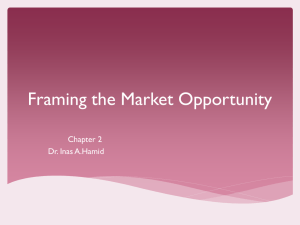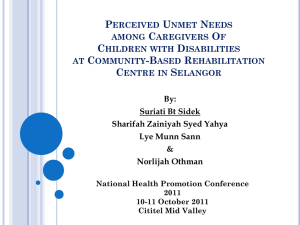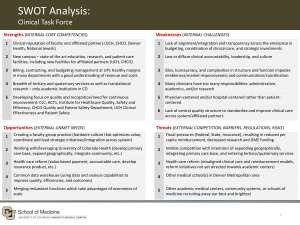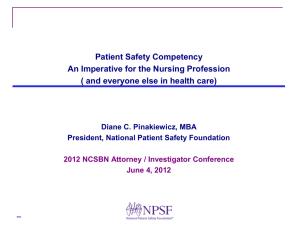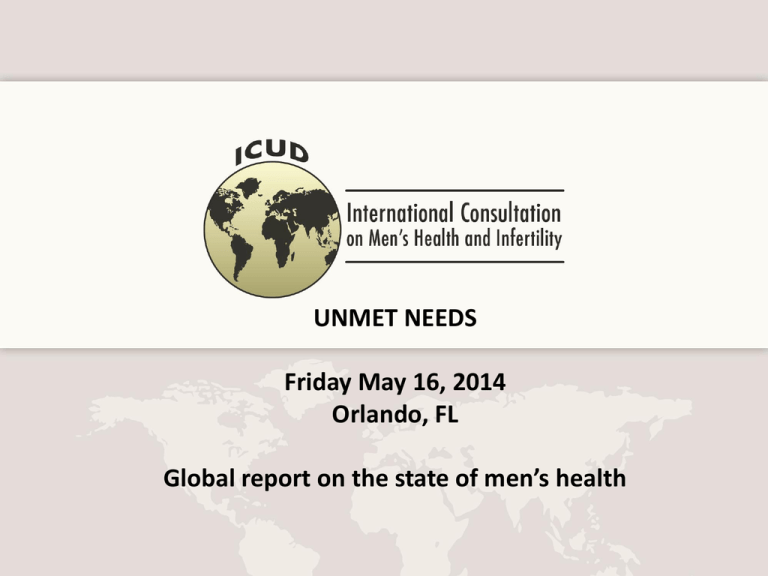
UNMET NEEDS
Friday May 16, 2014
Orlando, FL
Global report on the state of men’s health
Committee members
Professor Alan White
Co-director Centre for Men’s Health, Leeds
Metropolitan University, England
Professor Allen Seftel
Chief, Division of Urology, Cooper
University Hospital, Camden NJ
Professor Doris Bardehle
Co-ordinator of the Scientific Board of the
Foundation of Men´s Health, Berlin
Professor Larry Goldenberg
Head, Department of Urologic Sciences,
University of British Columbia, Canada
Dr Chris Ho Chee Kong
Urologist/Sexual Medicine Consultant,
Universiti Kebangsaan Malaysia Medical
Centre, Malaysia
Professor Gary Wittert
Head, Discipline of Medicine, Director,
Freemasons Foundation Centre for Men’s
Health, University of Adelaide, Australia
The work of the Unmet Needs Committee
• To identify what can be learned about the
health of men from the current national and
international men’s health reports
• To liaise with the other Committees to
determine the unmet needs from their new
analyses
• To prepare a chapter giving an overarching
statement on the state of men’s unmet needs
for the ICUD report
Reports covered
The reports covered in the first phase analysis include:
The 2011 European Commission ‘State of Men’s Health in Europe’ (SOMH) report;
The Health of Australia’s Males: 25 years and older (2013);
‘Where are the Men? Chief Medical Health Officer’s Report on the Health &
Wellbeing of Men and Boys in Northern BC, Canada (2011)
A Roadmap to Men’s Health: Current Status, Research, Policy and Practice (2010)
Canada
Asian Men’s Health Report (2013).
There have also been a number other important country reports that have been
referred to from Germany, Ireland, Denmark and Austria.
Structure to the review
The male population
Health Status
Social determinants and intersectional factors
Lifestyle & preventable risk factors
Health Services and Health Service Utilization
Communicable diseases
Non-communicable diseases
Mental Health
Accidents, Injuries and violence
Sexual and Reproductive Health
Academic and research base for men’s health
Policy Development
Overarching statement on key unmet needs
The Male Population - Demographics
The reports cover nearly 2½ billion men across the globe.
In all the countries covered by the reports there have been
changes noted in the demographics of the male population,
with the most significant being the increasing number of the
elderly and very elderly.
The SOMH report notes that this is mirrored by a fall in
working age men as a result of reduced birth rates
The Male Population – unmet needs
There is a lack of research that has explored the health implications of men’s
changing demographics.
Greater attention needs to be placed onto the educational approaches taken with
boys.
There needs to be better recognition of the impact of being a father plays on the
health of men and their children.
There is an absence of any real strategic discussion on how the aging population
will be managed.
There is a lack of strategy to support the many men who are working as full time
carers for relatives and friends
Health Status – unmet needs
A notable feature from all the reports is the high level of
premature death in men (for instance, 630,000 males,
300,000 females across the EU27 die during their working
years – 15-64 years).
All the reports highlight the wide range of life limiting
diseases men are exposed to and that many of these
premature deaths are avoidable, with estimates ranging from
50% to 70%.
The high rate of premature mortality of men is one of the
main unmet needs in Men´s Health and has to be
recognised and seen as a priority action point.
Social determinants and intersectional factors –
Unmet needs
• More research is required exploring the impact of the social
determinants and intersectional factors on men and how
these differ from their effect on women?
• The collection of socio-demographic data in the population
statistics / or health interview survey should be guaranteed in
all countries for stratified analyses of health status.
• More focus is needed on the health of men at the times of
transition, both personal (i.e. divorce) and societal (i.e.
recession).
Lifestyle & preventable risk factors – Unmet needs
Poor lifestyles and preventable risk factors need addressing to
reduce the high rates of premature death and morbidity in men.
But men should not be seen as solely to blame - this is a society
wide issue.
There is still a lack of smoking cessation policy in many countries,
which needs to be addressed and this includes public awareness
programme, clinical services, clinical practice guidelines, screening
programmes, health care practitioners training, school health
education and research.
Lifestyle & preventable risk factors – Unmet needs
In many countries over 60% of the male population is either
overweight or obese, leading to high levels of co-morbidity.
Male focused weight loss interventions should be instigated.
Greater attention needs to be given to getting men more
physically active and the avoidance of sedentary behaviour.
Greater focus on support for managed alcohol consumption and
the avoidance of illicit drug use.
Health Services and Health Service Utilization
- Unmet needs
Many men are missing out on preventative health care.
Greater development is needed of health promotion initiatives that
support men to adopt positive health behaviours and to increase control
over their lives.
Health services need to be focused onto the specific target group, rather
than taking a ‘one-size-fits-all’ approach.
Health and social services need developing with a clear focus on gender
competency in the delivery of services - health services should be more
male friendly.
Health Services and Health Service Utilization
- Unmet needs
More school-based and parent-oriented programmes and practical
sessions with boys and young men are needed to increase knowledge and
help seeking skills with regard to health.
More attention should be given to the opportunity of reaching out to men
in the workplace and sporting settings where they are more likely to be
successfully targeted.
Greater partnership building with agencies who have access to men, such
as prisons, welfare services, employment exchanges, homeless shelters, to
improve access to health services.
Health Services and Health Service Utilization
- Unmet needs
Greater attention should be paid to the training of health and
social care professionals to communicate more effectively with
men.
Consideration should be given to the development of Men´s
health centres in a similar way to the established women´s
health centres.
There should be qualification profiles developed for “Consultants
for Men´s Health”.
Communicable diseases - Unmet needs
Immunisation programmes that reach into male communities
are needed, especially those most at risk.
Many countries are still resisting developing policies relating to
HIV prevention and treatment.
Changing attitudes towards HIV are affecting prevention
campaigns. More work is needed to reach out to men who have
sex with men and Intravenous drug users.
Non-communicable diseases – Unmet needs
Getting a more robust research agenda developed on the
causative factors relating to men and the non-communicable
diseases seems warranted.
Many men are walking around with undiagnosed high
cholesterol, hypertension and diabetes through ineffective
early detection health programs.
Non-communicable diseases – Unmet needs
Few countries have a cancer plan to tackle men’s high burden of
cancer.
Many men are still unaware of the signs and symptoms of cancer,
including prostate cancer.
There is a need to de-link diagnosis and treatment of prostate cancer.
Improved diagnosis and treatment regimens are needed for respiratory
disorders to reduce chronic morbidity.
More awareness raising needed on men’s risk of osteoporosis, both for
the public and health care professionals.
Accidents, injuries and violence issues – Unmet needs
All countries require Public Health policy measures at a population level
to address the harmful risks behaviours which cause all kinds of accidents.
Many countries have a lack of road traffic accidents policy and agenda.
To reduce the health gap between countries in the field of Road Traffic
Accidents - the low mortality level of accidents in Netherlands should be a
benchmarking model for other countries.
Intervention programmes are needed for male perpetrators and male
victims of violence.
Mental Health
There seems to be high levels of undiagnosed mental health
problems in men, this would seem to be linked to the
definitions of anxiety and depression in men and the and the
poor sensitivity and cultural inappropriateness of the
diagnostic tools
Mental Health – Unmet needs
There is an urgent need to support men to recognise and cope effectively
with stress.
There is the need for a clear framework for suicide prevention and mental
health service provision that will support men who experience stress in
their lives.
There is the need to have positive mental health promotion campaigns to
reduce the stigma of mental health problems to encourage men to seek
help.
Mental Health – Unmet needs
There are unmet needs for particular groups of men and boys who have
special mental health concerns, i.e. veterans, men in the criminal justice
system, older men, men living in rural areas, minority ethnic men, men
with eating disorders, men with post-traumatic stress disorder, mental
health problems of gay men, homeless men, mental health problems of
men who have been sexually abused in childhood or sexually assaulted as
adults.
Sexual and reproductive health – Unmet needs
National sexual health strategies are needed to address the sexual and
reproductive health needs of men.
There is limited data on the appropriate use of testosterone replacement
therapy .
Men and health professionals are not aware of the full health implications of
erectile dysfunction.
Relatively common causes of hypogonadism, for example Klinefelter
syndrome are not screened for, despite the data supporting early
intervention.
Greater public awareness of the sexual and reproductive health needs of
men is required.
Limitations of the current Men’s Health Reports
Limitation on data comparability
– They don’t all share the same framework
– Not all the topics are covered in each report
– Topics are covered in different ways making it difficult to know if
you are comparing like with like
– There may be issues with regard to coding quality of morbidity
and mortality data
Limitation of data availability
–
–
–
–
Not all countries collect detailed data
Difficult getting age stratified data
Difficult getting sex-specific data
Lack of data on social determinants and intersectional factors
• Limitations to the coverage of the reports
– No data from the USA and South America and only part of
Canada
– There are a number of countries not covered by any of the
reports: i.e. Belarus, Ukraine, New Zealand
– No data from Africa
Academic and research base for men’s health
There is a growing field of gender medicine that needs to be encouraged
and in addition it’s important to develop specialised academic
programmes on men´s health.
This work needs to be appropriately funded through national and
international bodies such as the NIH and the EU-Framework programmes
for Europe.
This work should also be supported by the development of research
Institutes with chairs for Men´s Health.
Policy development
Though the reports cite that many policy developments have had a major
effect on the wellbeing of men, such as no-smoking bans, enforced road traffic
legislation and workplace health and safety, these are not universal.
Many countries require encouragement and support to address populationwide public health needs.
The Asian Report identified a widespread lack of policy for male specific
issues.
Policy development
There is an overall lack of policy aimed specifically at the health and wellbeing
of men.
This policy would need to span the social determinants of health and be
focused onto men’s emotional and mental health as well as physical health.
Policy should aim to help develop a positive self-image for men, which opens
up better life perspectives and to act to reduce the risks men face and to
enable the development of protective factors.
Policy development
This policy should be developed within the countries, but should be promoted
and supported by major international health organisations such as the World
Health Organisation, the World Bank, the United Nationals and the European
Commission.
These organisations can support this work by, for instance establishing a
health indicator within the European Commission’s Core Health Indicator set
(such as ‘difference in life expectancy between males and females, premature
mortality males and females, suicides with disaggregation of diseases and
conditions by age and sex).
Policy development
There should be a concerted effort to establish a national action plan for
men’s health and support should be given to help guide countries in
developing and implementing a national men’s health policy.
Consideration should also be given to the creation of Centre for Excellence for
Men’s Health and the strengthening of the International Society for Men’s
Health to enable it to have a greater role in the development of men’s health
in each country.
In counties that do not already have strong men’s health organisations, this
work should support the establishment of men/gender health associations in
all countries under the roof of public health associations.
Areas of concern regarding men’s health
Overarching statements on key unmet needs
The reports all note that men’s health has been lacking attention, and
this has adversely affected the opportunities to reach out to men to
reduce premature death and to create healthier lives for men and
women, and boys and girls.
There is a real need to have greater recognition of the interplay between
physical and mental health with more integrative approaches to overall
wellbeing.


